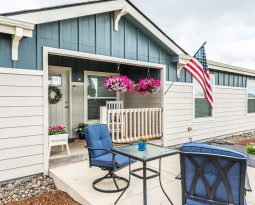Is It True That a Mobile Home is Less Safe in Storms? It Depends on When it Was Built
It is conventional wisdom that when tropical storms like Elsa blow in, you do not want to be living in a “mobile home”. How many times have we read stories about storm damage that focused on the debris that used to be a mobile home park?
Many people who live in the south and southeast reside in a “mobile home” or manufactured home. It’s no secret that older mobile homes often do not fare well during tornadoes, tropical storms, or hurricanes.
At last count, Florida had about 828,000 mobile homes/manufactured homes. More than 600,000 of them are older mobile homes, meaning they were not built to current hurricane standards. That is critically important when you understand how factory home building standards have changed in recent decades for all homes.
But is it true that mobile homes are less safe in storms? The answer is, like most nuanced answers, it depends.
One consideration: When was it built?
In the 1940s, 50s, 60s, and into the early 1970s, the “mobile home” burst upon the housing scene as a form of housing that most anyone could afford. The incredible demand resulted in dozens of manufacturing plants building thousands of low-priced mobile homes throughout the country, in states where regulations governing construction and health and safety were virtually non-existent.
In many ways, today’s manufactured homes still suffer from the stigma of “mobile homes” built before June 15, 1976, when the U.S. Congress passed legislation to establish a federal building code for mobile homes. This legislation is the Federal Manufactured Home Construction and Safety Standards Act, administered by the U.S. Department of Housing and Community Development, (commonly known as the HUD Code). A “mobile home” and a “manufactured home” are not one-in-the-same. The legislation ended the production of new “mobile homes,” and legally and effectively classified the succeeding factory-built housing as “manufactured homes.” In fact, there have been zero mobiles built in over four decades!
HUD Code wind and storm regulations were amended in 1980 and again in 1994 requiring new manufactured homes to comply with home building standards in pre-designated storm susceptible regions of the country indicated on the HUD Wind Zone Map of the U.S.A. Included in those regulations are specific requirements regarding manufactured home construction, installation, and ground anchoring to resist wind forces as required by the HUD Zone Map designations.
Today’s Manufactured Homes Are As Safe As Traditional Homes During A Storm, and in tornado and hurricane zones the standards for manufactured homes are more stringent than regional and national building codes for site-built homes.
In 1994, HUD revised and increased its wind safety standards after Hurricane Andrew struck in 1992. The result was that during the four hurricanes that struck Florida in 2004, not one manufactured home built after 1994 was destroyed by hurricane-force winds!
In 2007, the federal government established standards requiring all new manufactured homes to meet minimum requirements for installation and anchoring in accordance with its structural design and windstorm standards.
A 2014 Insurance Institute for Business & Home Safety (IBHS) test found that manufactured homes performed better at high winds than traditional-site-built homes when any attached structures are properly installed. It also suggested that improperly installed attached structures like carports and patio roofs caused about 80 percent of the damages in manufactured homes.
ManufacturedHomes.com urges individuals to be safe during a storm and to seek proper shelter. “A tornado and hurricane’s deadly force does not selectively discriminate between a site-built, a manufactured home or any other structure.”







